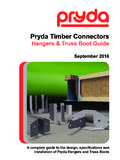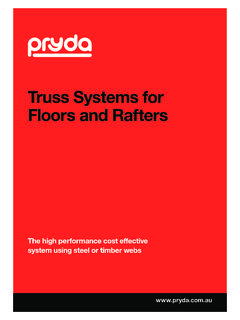Transcription of Pryda Timber Connectors
1 Pryda Timber ConnectorsConnectors & Tie-Downs GuideSeptember 2016A complete guide to the design, specifications andinstallation of Pryda Connectors & Tie-Downs ESSENTIAL NOTES Pryda PRODUCT GUIDES Copyright: Pryda Australia - A Division of ITW Australia ABN 63 004 235 063 - 2016 INTRODUCTION The information in this Product guide is provided for use in Australia by architects, engineers, building designers, builders and others. It is based upon the following criteria: 1. No Substitution: The products covered by or recommended in this guide must not be substituted with other products. 2. Design Capacity Basis: See Codes & Standards following. 3. Supporting Constructions: Constructions using Pryda products must be built in accordance with the NCC (BCA) or an appropriate Australian Standard. Note: This includes appropriate corrosion protection- See Corrosion Protection following. 4. Correct installation : installation of Pryda products must be strictly in accordance with the instructions in this guide .
2 5. Current guide Version Used: The current version of this guide , including any amendments or additions, must be used. Users are advised to check the Pryda website, , on a regular basis for the most current design guides. CODES & STANDARDS Product design capacities in this guide have been derived from: (a) Results of laboratory tests carried out by or for Pryda Australia (b) Engineering computations in accordance with the relevant Australian Standards, ie: Timber Structures. Part 1: Design Methods. AS/NZS1170 series Structural Design Actions. AS4055-2006 Wind Loads for Housing. Design capacities tabulated in this guide apply directly for Category 1 joints. For all other joints, reduce design capacities by using the factors as specified in General Notes (if applicable). Design capacities are related to the Joint Group of the Timber as defined in AS1720 and AS1684.
3 If the Joint Group of Timber members joined together varies, the lower group must be assumed for design, for example, JD5 is lower than JD4. DEFINITIONS Special terms used in this guide are as defined in Australian Standards, including: Design Capacity: The maximum Limit State Design load (aka action ) which the product can safely support under the specified load condition, eg, + (dead+roof live). See General Notes for details (if applicable). Joint Group: Classification of a Timber according to its fastener-holding capacity. See General Notes for details (if applicable) CORROSION PROTECTION Most Pryda products are manufactured using Z275 light-gauge steel, having zinc coating of 275 gsm (total weight). This protection is adequate only for INTERNAL applications in most corrosive environments, except areas that are classified as heavy industrial or those subject to high humidity (eg, enclosed swimming pools).
4 Under these circumstances, seek advice from experts as special protection will be required. Note: INTERNAL areas are those within the building envelope that are kept permanently dry. and , Australian Standards for Residential Timber Frame Construction stipulate a minimum Z275 steel for all sheet metal products used in an internal environment. In areas outside the building envelope that are exposed to repeated wetting (EXTERNAL areas), Pryda s stainless steel products or equivalent should be considered. Some alternatives include hot dip galvanised or powder coated steel, which are not supplied by Pryda . For more detailed information, read Pryda s Technical Update on Corrosion Resistance of Pryda Products or contact a Pryda office. PRODUCT CERTIFICATION Pryda Australia warrants: Products in this guide are free from defects in the material and manufacturing Design capacities are in accordance with test results or current, relevant Australian Standards and the Building Code of Australia.
5 Pryda products are structurally adequate provided they are designed, installed and used completely in accordance with this guide . This warranty applies only to: Products in this guide . Products used in the specified applications and not damaged after manufacture and supply. Joints free from wood splitting, decay or other Timber defects at the joint or within 150 mm of the joint. INSTRUCTIONS FOR installation These notes are provided to ensure proper installation . 1. All fasteners used must be manufactured by reputable companies and be of structural quality. 2. Connectors must not be installed on Timber which is split before or during installation . If the Timber is likely to split as fasteners are driven, fastener holes must be pre-drilled. 3. Do not overload the joints during construction or in service. 4. Hole diameter for bolts in seasoned Timber must not be more than mm larger than the bolt diameter to achieve a snug-tight connection.
6 Specified washers must be installed against the Timber face. 5. Use proper safety equipment and due care in installing these Connectors . 6. Any gaps in joints between the Timber members must not exceed 3 mm. 7. Do not over-tighten screws. Pryda Connectors & TIE-DOWN Connectors guide SEPTEMBER 2016 3 Pryda Connectors & Tie-down Connectors guide TABLE OF CONTENTS ESSENTIAL NOTES- Pryda PRODUCT GUIDES 2 STUD TIES Fix wall plates to studs at bracing units and other joints 13 SELECTION guide Quick, easy guide to selection of a suitable tie-down connector for Timber frames 4 TRIPLE GRIPS Multi-purpose tie-down and all-purpose Connectors 16 BATTEN STRAPS Roof batten tie-down connector 7 HIGH CAPACITY TIE-DOWN PLATES To resist extreme tie-down forces 17 CYCLONE STRAP Ties down rafters or trusses to supporting frame 8 HOLD DOWN BRACKET Tie-downs of trusses/rafters for a concealed application 18 JOIST STRAP Ties down Timber members at right angles 9 CYCLONIC GRIP On-site tie-down connector for roof trusses, rafters or wall studs 19 MITRE PLATES Connect creeper trusses to hip trusses 10 PURLIN CLEAT & CPB BRACKET Tie-down Connectors for concealed application.
7 CPB is especially designed for fixing into blockwork. 20-21 MULTIGRIPS AND MINIGRIPS Multi-purpose tie-down and all -purpose Connectors 11 TRUSS TIE On-site tie-down connector for roof trusses and rafters 22 Pryda HITCH For lateral connections of trusses to non-load bearing walls 12 UNITIE Ties down Timber members at right angles 23 Machine Driven Nail Use General Note mm Duo-Fast C SHEG (ie: screw hardened electro galvanized) machine driven nails (code D40810) or equivalent may be used instead of the specified mm Pryda Timber Connector Nails to fix selected Pryda Connectors provided that the following requirements are strictly adhered to: Design capacities shall be reduced by 20% using the same number of nails as specified for the Connectors and Nails shall be driven at nail spacings and edge distances similar to the hole pattern, ensuring that these nails are notdriven into the holes or located not closer than 5mm from the edge of a care must be taken when using machine driven nails as the prevailing installation practices tend to inhibit compliance with the above requirements.
8 Note: the use of machine driven nails for fixing Pryda Multigrips or Triple Grips is not acceptable in the state of Queensland. Some of other Pneumatic Coil screw hardened nails considered equivalent to D40810 are Paslode 32x (B25110), Duo-Fast 32 x (D41060) and Duo-Fast 40 x (D42360) Pryda Timber Connectors Connectors & Tie-down Connectors guide Pryda Connectors & TIE-DOWN Connectors guide SEPTEMBER 2016 4 SELECTION guide Selection guide for use with AS1684 Residential Timber -framed Construction Wind upliftTie-down Introduction AS1684-2010 Residential Timber -framed Construction requires that some frame members be tied-down against wind uplift load. Section 9 of Parts 2 and 3 of the code includes tables of the Uplift Force (kN) to be resisted at joints in frames. To assist designers and builders to meet these requirements, this selection guide provides tables of design loads and capacities for Pryda Connectors & Tie-down Connectors .
9 How to Select a Suitable Connector To use this guide follow these steps: 1. Determine the Joint Group of the Timber . Joint groups are tabulated in Pryda 's Timber Data (see table in this page) or in AS :2010. 2. Read off the Design Uplift Force from AS 1684 Residential Timber -framed Construction or other reference. 3. Select the appropriate table for the type of joint required ie: Table No. Joint Type Page 1 Roof battens or purlins to trusses, rafters or beams 3 2 Roof trusses, rafters or beams to supports 3 3 Wall plates to studs 4 4 Wall plates to concrete slab floors 4 4. In the selected table, chose a Pryda Bracket or Strap with sufficient design capacity for the joint group and design load. For higher design loads, some Pryda Connectors can be doubled up (ie: two Connectors used) to provide twice the capacity. These Connectors are: Cyclone Straps, Joist Straps, Multigrips, Triple Grips, Purlin Cleats, Hold-down brackets, Cyclonic Grips, CPB brackets and Uni-Ties.
10 Doubled Up Connector 5. Order the Pryda Bracket or Strap, preferably by its code as tabulated in the following tables. Timber Joint Groups Joint groups for some common Timber are tabulated below. For further information refer Table and in Australian Standards :2010 Timber Structures Part 1. Timbers Strength Group Joint Group Dry Green Dry Green Oregon (Douglas fir) America SD5 S5 JD4 J4 Oregon from elsewhere SD6 S6 JD5 J5 Radiata pine, heart-excluded SD6 NA JD4 NA Radiata pine, heart-in SD6 NA JD5 NA Slash pine SD5 S5 JD3 J3 Ash type hardwoods from Vic, NSW highlands & Tas SD4 S4 JD3 J3 Non-Ash type hardwoods from Qld & NSW SD3 S3 JD2 J2 Note on Engineered Timbers: Most standard LVLs are assigned a JD4 joint group, and some JD3. Seek advice from the relevant LVL manufacturer for confirmation. Tie-down Design Loads & Capacities The tabulated capacities in Tables 1 to 4 are for Category 1 joints.






